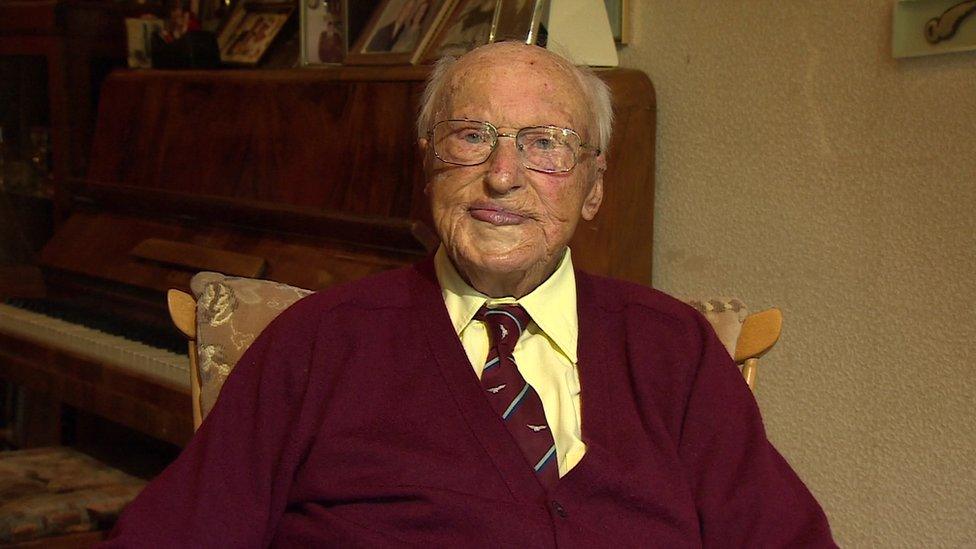'I cheated death and joined the Guinea Pig Club'
- Published

Desmond was badly burned in the crash
When Flying Officer Desmond O'Connell's bomber plane was sent on a mission to sink the Bismarck in 1941 only to crash into a hill in flames, the 21-year-old was so badly burned his colleagues contacted his mother to make arrangements for his funeral.
An observer in the back of the plane, Des, as he is known, was the last of the crew to crawl out through the cracked fuselage and was doused in petrol.
The grass outside was alight and he went up in flames, burned all over but for the areas covered by his US-issue flying jacket and boots.
But Des was lucky enough to find his way to Queen Victoria Hospital in East Grinstead, under the care of the pioneering plastic surgeon Sir Archibald McIndoe.
There, he underwent more than two years of painful experimental surgery.
Desmond was doused in fuel when his plane crashed
"I had new chins - three times they operated because they didn't go quite right. I had new eyelids, new ear tips, and my legs were grafted too," he told the BBC at his home this week.
Sir Archibald, realising how the badly burnt and disfigured men on his wards were struggling to adapt to everyday life, decided to give their morale a boost.
Sir Archibald McIndoe with some of his patients
"He said, 'Right, you are all now members of the Guinea Pig Club,'" said Des, who is now 96.
Formed in June 1941 with just 39 members, by the end of the war they numbered 649. Primarily a drinking club, with social events and trips into the town, the group formed close bonds for life, while Sir Archibald developed plastic surgery techniques some of which are still in use today.
Dwindling numbers
"I'm sure that the operations I had - four, five or six months later, would have been done differently. Because each time, it was an experiment," said Des.
Today, only 17 members of the Guinea Pig Club survive in the UK, their numbers dwindling as the men enter their mid-90s.
A commemorative monument is being unveiled by the Duke of Edinburgh at the National Memorial Arboretum in Staffordshire, recognising the work of Sir Archibald, who died in 1960, and the bravery of his Guinea Pigs.
"The Guinea Pig Club", as the men affectionately named it, was only intended to last until the end of the war
Sir Archibald was instrumental in developing the walking-stalk skin graft, a procedure in which a flap of skin was fashioned into a tube and attached at both ends to the patient, being slowly removed and reattached - "walked" along the body until it reached the area needing the graft.
Photographs of men being treated during World War Two feature these tubes, often connecting their noses with skin on their torso or arms.
Modern developments including microsurgery, in which the blood vessels of a skin graft can be reattached at the new site, eliminated the need for this type of procedure.
Sir Archibald's legacy has endured, not least at the Queen Victoria Hospital, now the leading burns and reconstructive surgery centre in the south-east of England.
Mr Baljit Dheansa, consultant plastic surgeon at the hospital, told the BBC: "Some of the approaches we still take in surgery hark back to what McIndoe did for his Guinea Pigs way back then.
"A philosophy of early burns surgery, and taking quite an aggressive approach, to get patients healed, but at the same time addressing the big deficiency that burn care and any surgical care had in the past, which was supporting them psychologically.
"He realised that providing that level of support helped their healing just as much as the skin grafts that he was applying on a daily basis."
- Published9 June 2014